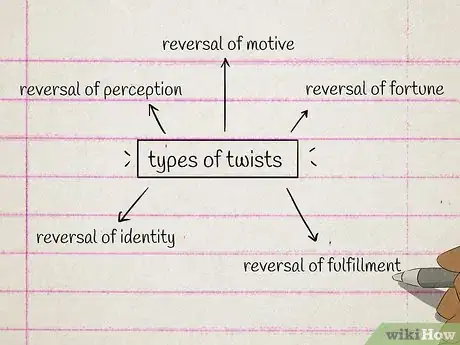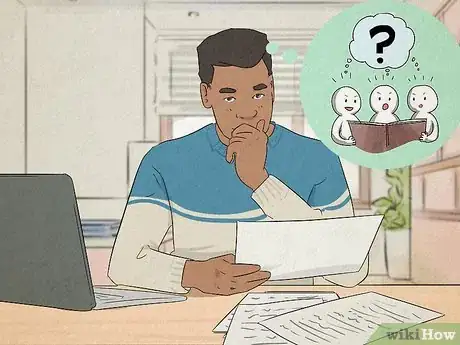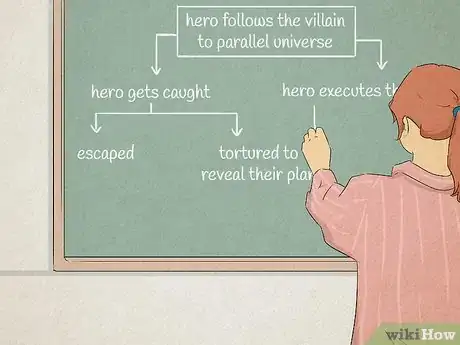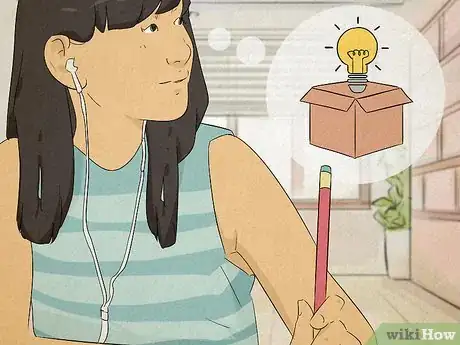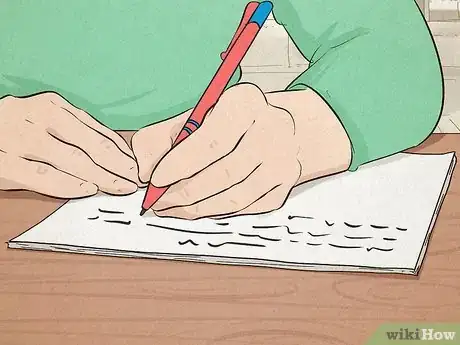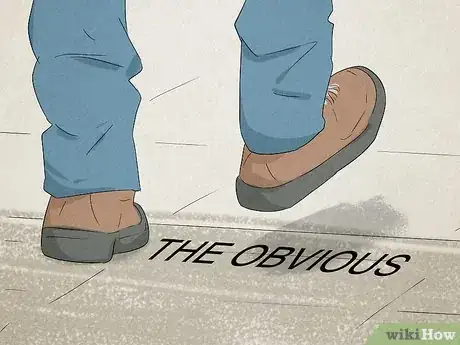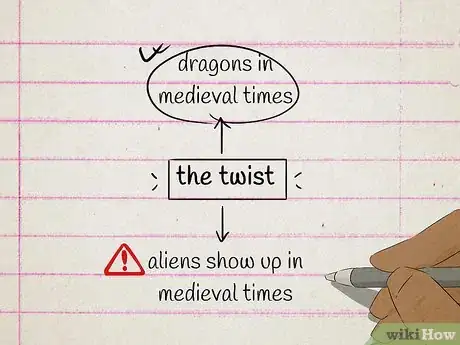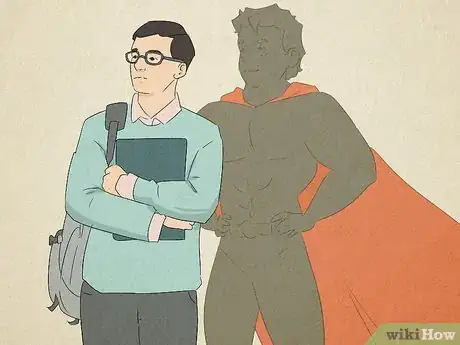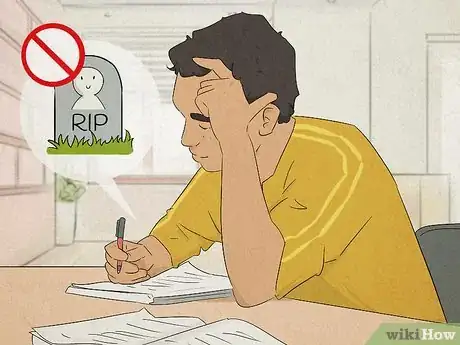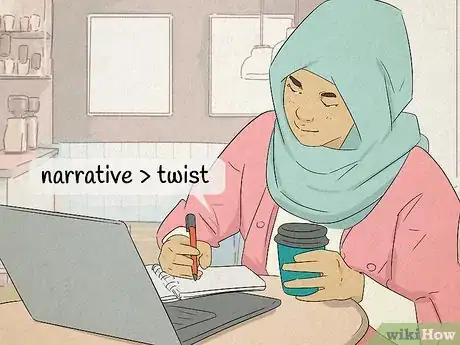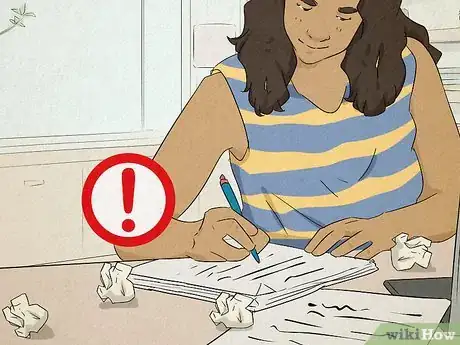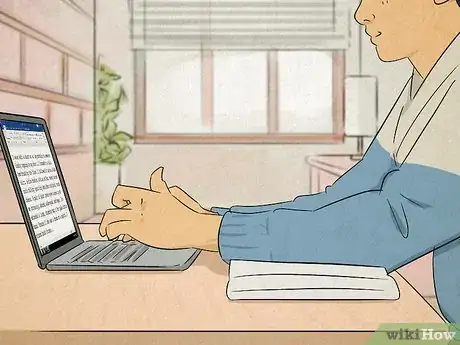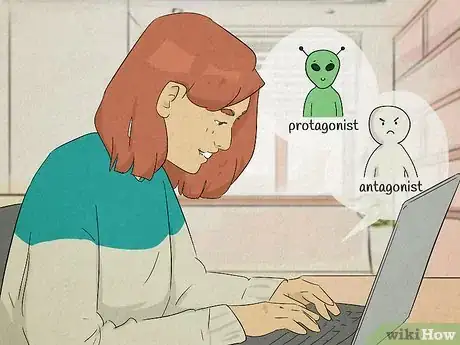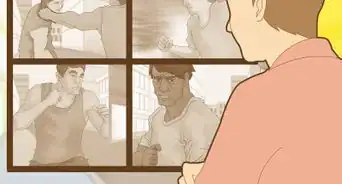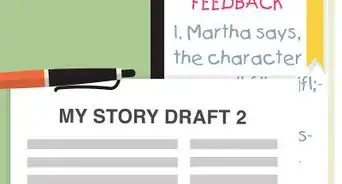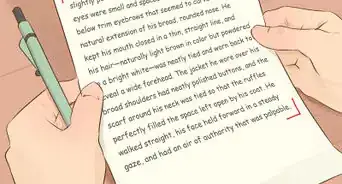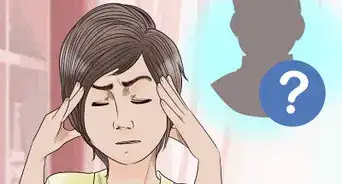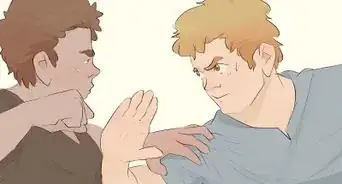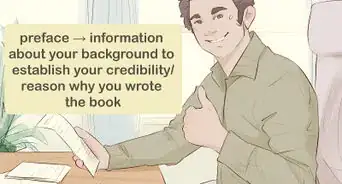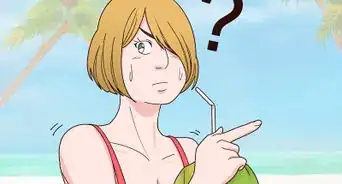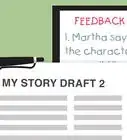This article was co-authored by Dan Klein. Dan Klein is an improvisation expert and coach who teaches at the Stanford University Department of Theater and Performance Studies as well as at Stanford's Graduate School of Business. Dan has been teaching improvisation, creativity, and storytelling to students and organizations around the world for over 20 years. Dan received his BA from Stanford University in 1991.
There are 7 references cited in this article, which can be found at the bottom of the page.
This article has been viewed 95,270 times.
A good plot twist can add dramatic flair to your story. However, writing an interesting twist can be a difficult task. It has to advance your narrative arc while, simultaneously, being subtle enough to be a surprise, yet not so outrageous that it is unbelievable.
Steps
Developing Your Twist
-
1Flesh out your story. Sketch out the overarching narrative that you are trying to create. What is the narrative environment in which your twist occurs? The world you are creating has its own logic and a set of rules to follow. Do animals talk? Can people fly? Your twist should adhere to these rules and make sense within the narrative world you have created.[1] Keep in mind questions like:
- What are the logical rules of the narrative universe you are creating?
- Does the plot twist abide by those rules?
- Does the twist make sense in the narrative universe created?
-
2Think about types of twists. Plot twists tend to fall into five different categories. Although it is important to creatively approach your twist and avoid adhering too strongly to a certain trope, considering these five categories may point you in the right direction. [2]
- Reversal of Identity – Someone turns out to be someone or something else.
- Reversal of Motive – The apparent actions of a character are revealed to be a deception, designed to conceal motives that are the opposite of what was assumed, aka “I thought he was after THIS, but he's really after THAT.”
- Reversal of Perception – The world that you have been led to believe is real is, in fact, false or incomplete.
- Reversal of Fortune – Fate intervenes to alter the fortunes of a character for better or worse.
- Reversal of Fulfillment – A character achieves something only to have another character take it away at the last second.
Advertisement -
3Anticipate your reader's reaction. When writing your twist, keep in mind how you want the reader to react. Imagine the desired reaction to the twist that will better help you construct your narrative. Constantly ask yourself what the reader expects from the narrative and try to avoid that. [3]
- Do you want the reader to feel a sense of certainty before you pull the rug out from under them?
- Are you trying to cultivate an atmosphere of uncertainty where there the direction of the narrative is unclear?
-
4Brainstorm ideas. Think about the scenario that you are trying to create and flesh out all of the possible outcomes. Your first idea for an amazing plot twist is probably not your best one and is unlikely to be the scene you use. Professional writers typically work through multiple scenarios before finding a twist that fits. Remember that there are no bad ideas during brainstorming. [4]
-
5Lay out all of the obvious narrative possibilities. Think about the apparent scenarios and their implications for your story. Thinking about the obvious scenarios might help you gain some interesting insights on how you should develop your twist. At the least, it will help you better understand which plot points to avoid.
-
6Think outside the box. Pursue ideas that might seem too outrageous or do not appear to fit. You ultimately want to find something that surprises your reader, so think big. Let these different scenarios simmer while thinking about what direction you want to take the story. Test these scenarios out. You might be surprised by which idea sticks. [5]
-
7Freewrite. Put pen to paper and let your thoughts flow. Write out multiple scenarios and explore a variety of outcomes. Reveal that the main character is a robot. Have eagles swoop down and save the protagonists at the last second. This is a writing exercise with no limits where you can flex your creative muscle. Write out as many ideas as you can, regardless of how clichéd, obvious, or ridiculous they are.
-
8Visualize the scene. Making a visual representation of your scene, and its place in the broader narrative is an excellent way to test out a twist. Drawing out your scene will work different parts of your brain and may help you find a new angle for your twist.
- Create a bulleted list or outline of your scene highlighting its place in the broader narrative structure.
- Draw out a network map of the narrative connecting multiple scenes.
Avoiding Common Pitfalls
-
1Sidestep the obvious. A plot twist needs to be unique or, at the least, capable of surprising your readers. Remember that you are trying to get them to say, “I didn't see that coming.” Keep in mind the story you are telling and write something that is out of the ordinary for the narrative.
- If a character is murdered in a story with five murders, the sense of surprise is gone, and predictability sets in.
- If a character has a special item that they have been using the entire story, do not have them use said item in your twist. The reader will expect that. Instead, see how your character does without their special item.
-
2Keep it reasonable. Do not make your twist so outrageous that it is unbelievable. It must be a surprise, but a reasonable one. Although your story may have fantastical aspects, it still has to adhere to the rules that you have created. Keep in mind that the more “out there” a twist is, the more you will have to foreshadow and ground it in the reality of your fictional universe.
- Be sure to foreshadow. A twist should not come out of nowhere.
- If your narrative takes place in a medieval world, do not have aliens show-up in your twist, unless you have given some clues that aliens are involved in the story.
- A noir detective story probably would not benefit from dragons, unless dragons are an integral part of the universe you are creating.
-
3Foreshadow your twist. For the scene to make sense to your reader, you need to provide adequate foreshadowing. Drop breadcrumbs throughout your story that hint at the twist to come. However, do not be too overt in your hints. Be sure to redirect suspicion, otherwise, the reader will see the twist coming. [6]
- If a character is going to reveal a secret identity, be sure to have hinted at this identity earlier in the narrative.
- When revealing a false perception, be sure to create your world in a way that provides brief glimpses of the true reality.
-
4Do not rely on gimmicks and clichés if possible. If you premise the twist on a well-known gag or trope, your reader will likely see it coming. Gimmicks can cheapen your story and make the reader feel tricked or deceived. You want your twist to heighten your reader's investment in the narrative, not undermine it.[7]
- Do not have the entire plot be the dream of one of your characters or the product of a simulation. Framing or nesting can add an interesting element to a story, but it has to significantly add to the punchline. It is unlikely that the reader will appreciate investing their time in a story that was an illusion. Avoid at all costs.
- The revelation that a character is actually the long-lost relative of another character is very much a soap opera cliché. If you are drawn to this twist, think of ways to make it your own.
- Avoid having one of your characters realize that they are a ghost. This is another notorious twist that the reader will likely see coming and not appreciate. In fact, avoid all M. Night Shyamalan-style twists.
Honing your Twist
-
1Emphasize the narrative, not the twist. Avoid using it as a springboard for the broader narrative. The twist should serve the plot and move it forward, not vice versa. Your story should not be so dependent on the twist that it loses its appeal after the reader figures out what is happening. Re-readability is important. A twist is well developed if the reader enjoys it just as much the second time they encounter it.[8]
- Do not start with an interesting twist and then start writing your narrative out from there. You will make the entire too contingent on this one moment.
-
2Create interesting situations. Your twist should be part of an exciting story situation that, if guessed by your reader, continues to excite them. Instead of being disappointed that they discovered the twist, the reader should be eager to understand the possibilities of what it entails for the broader narrative.[9]
-
3Advance the plot. Your twist should always be escalating the plot, not de-escalating it. You should scrap a scene if it detracts from or deescalates the narrative arc. If the twist brings your story to a screeching halt, it probably is not worth developing. [10]
- Do not use a twist for its own sake. Although it may be very clever, it should help move the story along and contribute the final punchline.
-
4Challenge genre stereotypes. If you are writing fiction for a certain genre, use the field's tropes to throw off the reader. Subvert the narrative norms in a way that makes sense but is unexpected. Take a tired cliché or trope, like one of the gimmicks mentioned above, and turn it on its head. Readers will appreciate you using something old in a new way. [11]
- If a certain kind of character is typically an ally of the protagonist, reveal them to be a villain.
- In a space opera, reveal the humans to be the villains instead of the aliens.
Expert Q&A
-
QuestionHow can I make my plot more engaging?
 Dan KleinDan Klein is an improvisation expert and coach who teaches at the Stanford University Department of Theater and Performance Studies as well as at Stanford's Graduate School of Business. Dan has been teaching improvisation, creativity, and storytelling to students and organizations around the world for over 20 years. Dan received his BA from Stanford University in 1991.
Dan KleinDan Klein is an improvisation expert and coach who teaches at the Stanford University Department of Theater and Performance Studies as well as at Stanford's Graduate School of Business. Dan has been teaching improvisation, creativity, and storytelling to students and organizations around the world for over 20 years. Dan received his BA from Stanford University in 1991.
Improvisation Coach Focus on creating a complex and interesting world that the reader engages with.
Focus on creating a complex and interesting world that the reader engages with. -
QuestionCan I put a twist in a comedic story?
 Dan KleinDan Klein is an improvisation expert and coach who teaches at the Stanford University Department of Theater and Performance Studies as well as at Stanford's Graduate School of Business. Dan has been teaching improvisation, creativity, and storytelling to students and organizations around the world for over 20 years. Dan received his BA from Stanford University in 1991.
Dan KleinDan Klein is an improvisation expert and coach who teaches at the Stanford University Department of Theater and Performance Studies as well as at Stanford's Graduate School of Business. Dan has been teaching improvisation, creativity, and storytelling to students and organizations around the world for over 20 years. Dan received his BA from Stanford University in 1991.
Improvisation Coach There's no reason you couldn't. You still want to make sure that your story has a character that the audience cares about. Some comedy is definitely based on undermining the story or playing with plot expectations, but you still need to have that central thread of a character that people latch on to.
There's no reason you couldn't. You still want to make sure that your story has a character that the audience cares about. Some comedy is definitely based on undermining the story or playing with plot expectations, but you still need to have that central thread of a character that people latch on to. -
QuestionHow do you lead to a good twist without plot holes?
 Community AnswerCreate your plot twist first, develop it more and then look for all the plot holes and how you could prevent them. Ask a trusted friend or family member to read through the story twist and find plot holes. It's often very helpful to have an outside view, but remember to take criticism well.
Community AnswerCreate your plot twist first, develop it more and then look for all the plot holes and how you could prevent them. Ask a trusted friend or family member to read through the story twist and find plot holes. It's often very helpful to have an outside view, but remember to take criticism well.
Warnings
- Use plot twists sparingly in a story. Too many twists and turns may confuse your reader.⧼thumbs_response⧽
References
- ↑ Dan Klein. Storytelling Teacher. Expert Interview. 22 March 2019.
- ↑ http://alecworley.weebly.com/blog/the-five-types-of-twist-ending
- ↑ http://www.writersdigest.com/editor-blogs/there-are-no-rules/4-ways-to-write-a-killer-plot-twist
- ↑ http://writingcenter.unc.edu/handouts/brainstorming/
- ↑ http://blog.janicehardy.com/2010/03/expect-unexpected.html
- ↑ http://www.helpingwritersbecomeauthors.com/5-ways-to-write-killer-plot-twist/
- ↑ http://www.writersdigest.com/editor-blogs/there-are-no-rules/4-ways-to-write-a-killer-plot-twist
- ↑ http://www.helpingwritersbecomeauthors.com/5-ways-to-write-killer-plot-twist/
- ↑ http://www.helpingwritersbecomeauthors.com/5-ways-to-write-killer-plot-twist/


